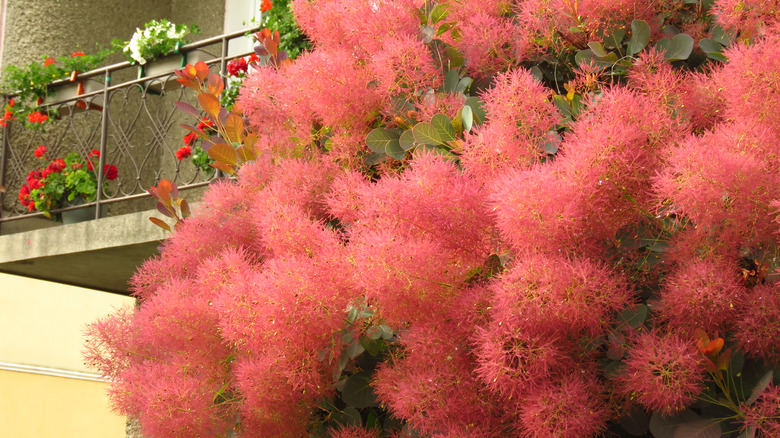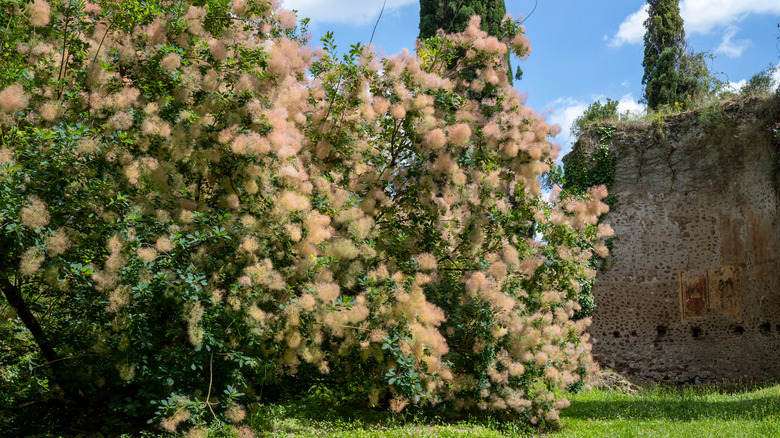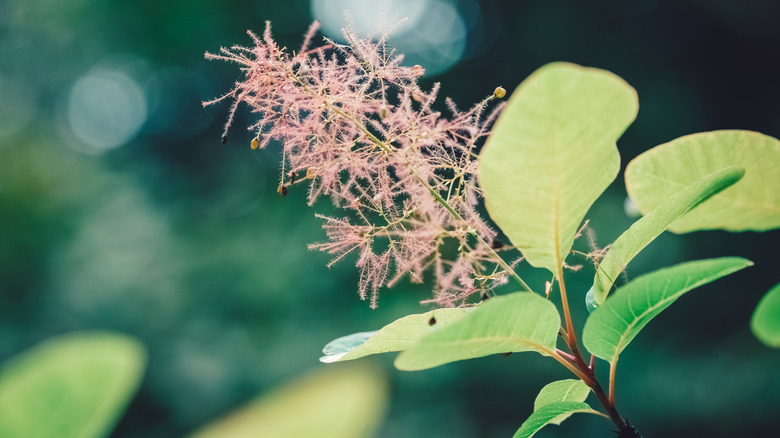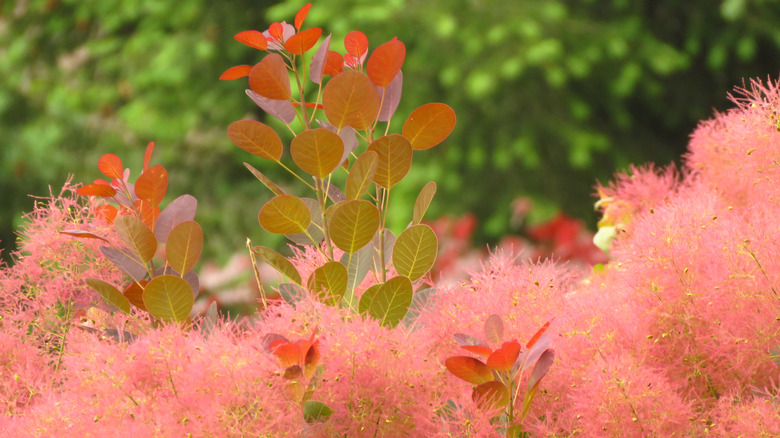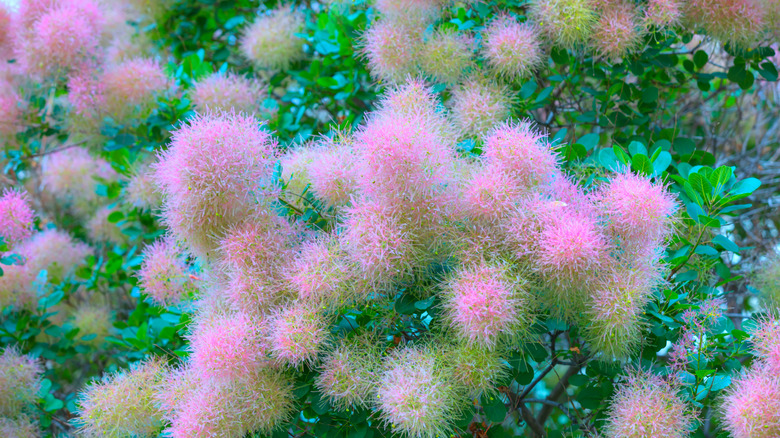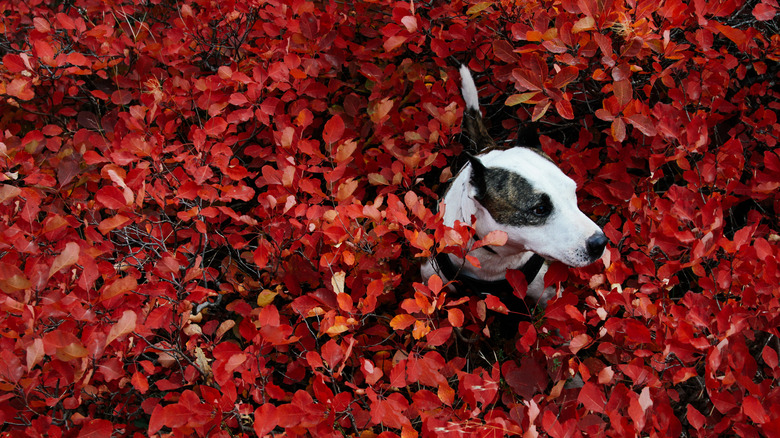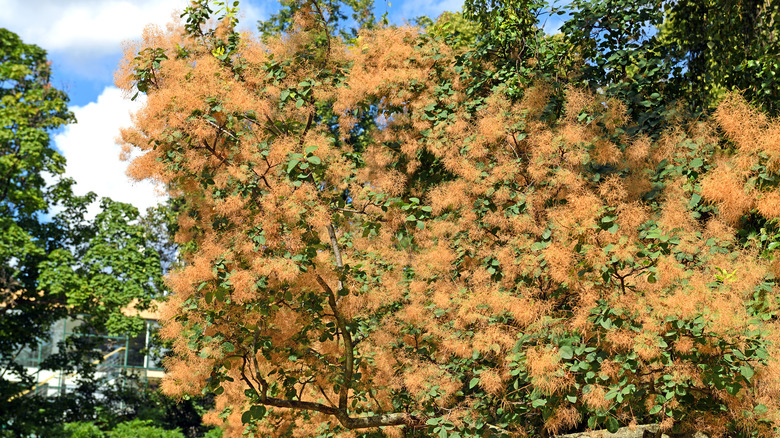How To Care For A Smoketree
The deciduous, shrub-like smoketree (Cotinus coggygria) is also often referred to as a smoke bush, mist tree, or Jupiter's Beard. When in bloom, the flowers are billowy clusters of brown or purple that look like bursts of smoke. The leaves on these trees are rounded, ranging in size from 1 to 3 inches long, and are green with subtle hints of blue depending on the amount of direct sunlight it receives. Smoketrees are perfect as accents in gardens or as colorful borders along your property line.
American species of the smoketree (Cotinus oboyatus) are cold hardy, and drought-tolerant and can live in zones 4 to 9 with proper care and maintenance. According to The Spruce, while smoketrees are found anywhere from southern Europe to China, the Eurasian species are somewhat less tolerant of the cold than its American cousins but can still be perfectly happy in zones 5 to 8. These unique trees have been readily accessible in nurseries since the late 1700s. Smoketree bark has been used in the past to make yellow clothing dye because it has a higher amount of tannins than Oak and Hemlock, says the Arbor Day Foundation.
How to use in garden
While it's always preferable to work with species native to your region, the smoketree is not considered invasive. Any variety of smoketree would be safe to add to any yard or garden, regardless of your location. If you live in an area that is prone to wildfires, smoketrees are perfect for firescaping your property because they are striking accent pieces that are herbaceous, tolerant to drought, and don't drop debris. This combination is ideal because it makes the fire more difficult to spread.
Because the size and shape of a smoketree depends on how you prune it, its uses are numerous. If left alone, it will grow to approximately 15 feet with multiple trunks at maturity, says The Spruce. Instead, you could prune it into a single-trunk tree or cut it back throughout the growing season to keep it as a shrub. If kept as a shrub, planting several smoketrees forms a beautiful hedge or natural privacy screen.
How to grow smoketrees
According to The Spruce, Smoketrees can be propagated by seeds or by stem cuttings. While it's easier to purchase a sapling from the nursery or propagate from stem cuttings, growing smoketrees from their kidney-shaped seeds is a possible but slow process. After harvesting the seeds, they must be soaked in water for 24 hours, changing the water halfway through, specifies Gardening Know How. Dry the seeds completely in a well-circulated area. When your region is past the threat of frost, you can plant your prepared seeds directly into your garden or yard by pushing them down into loamy soil until they are about ½ inch deep.
Propagation by stem cuttings is considered better than growing by seeds because the features of the parent plant will be cloned by the propagated cutting. Wait to take cuttings until summer. Cut a 4 to 5-inch length from a mature stem. Snapping the stem should break away easily instead of bending or shredding like a young stem. Remove any leaves and strip the bark from one tip of the propagated piece. Dip the exposed end in rooting hormone to help stimulate new growth. Plant the propagated stem in moist but well-draining soil.
Since your goal will be to maintain the soil's moisture without overwatering, consider building a mini greenhouse for your stem cuttings by staking the pot (chopsticks work well as stakes for this) and covering it with plastic wrap or a plastic bag.
How to care for smoketrees
The beauty of the smoketree is in its hardy and tolerant nature, which makes them relatively easy to take care of them. According to The Spruce, smoketrees prefer loamy soils that are well-draining. While they are hardy enough to tolerate both alkaline and acidic soils, they are much happier and will be capable of more growth if the soil is more alkaline. To make your soil more alkaline, you'll need to raise the pH. To do this organically, you can add a tablespoon of baking soda to a gallon of water every three to four months. To regularly monitor your soil, you can find pH test kits online or at any garden supply store.
As per Gardening Know How, Smoketrees can survive in partial shade, but they prefer at least six hours of full sun. It's not necessary to fertilize your smoketrees, says Martha Stewart. Instead of springtime fertilizing, provide a layer of compost, followed by a hearty helping of mulch. Wait to prune your smoketree to your desired shape until after flowering, ideally before the first week of July. You can cut the smoketree to the ground each winter, but the regrown shrub won't produce flowers on newer branches.
Smoketree varieties
The Piedmont Master Gardeners Association calculates that between the Eurasian and American species of smoketree in the family Anacardiaceae, there are over 800 varieties.
- The Cotton Candy Smoketree (Cotinus obovatus 'Northstar') is popular for its versatility as a tree or pruned into a shrub because it can grow a maximum of 18 feet tall and 15 feet wide. It is hardy enough to thrive in urban environments. The beautiful plumes of mauve that give the smoketree its name is indeed reminiscent of cotton candy.
- The Royal Purple Smoketree (Cotinus coggygria 'Kromhout') has dramatic dark green foliage and warm burgundy flowers when planted in full sun. The Royal Purple is native to Holland but was transplanted to American soil in the 1950s, says North Carolina State University.
- The Spruce applauds Daydream smokebush (Cotinus coggygria 'Daydream'), a shorter variety of smoketree that makes wonderful hedges. At maturity, the Daydream reaches only 10 feet in height and spreads 10 feet wide.
- Velvet Cloak (Cotinus coggygria 'Velvet Cloak') has lush purple foliage and spectacular pink flowers and grows well in zones 5-9.
- The Audobon Native Smoketree (Cotinus obovatus) is sure to turn heads with its bright orange and yellow flowers and blue-green foliage.
Is smoketree toxic?
According to The Spruce, smoketrees are mildly toxic to humans when consumed. Fortunately, the entire tree is pet friendly! Your cats won't get sick if they happen to eat a few of the leaves or fruits inside the billowy flowers. If Fido gnaws on a fallen stick, don't worry – your pup won't get sick.
Both Eurasian and American species of smoketrees are members of the Anacardiaceae family, more commonly known as sumac. The blooms are safe to touch, but the sap contains urushiol, which is the same compound that causes allergic rashes from the smoketree's poison ivy and poison oak cousins. When trimming smoketrees, wearing gloves and long sleeves is highly recommended, so your skin is not exposed to the irritating compound in the sap.
It is very important that you do not burn the branches that you have pruned from the tree because the toxins from the burning smoketree's sap makes the smoke potentially dangerous to inhale.
How to repot smoketrees
If you would like to keep your propagated smoketree cutting in a container, the plant is tolerant enough of a variety of soil conditions to do so, says SFGate. Since they will become top-heavy as they grow tall, first fill your container with about 3 inches of gravel. The gravel will also help with water drainage, which is essential to keeping the roots of the smoketree healthy. Some add a brick or two on top of the gravel for extra weight to counteract the weight of the tree as it grows. To repot or transplant your smoketree, place it in the new container you've already prepared with the layer of gravel and bricks and fill the surrounding gap with a 50/50 mixture of sand and soil.
Do not repot the smoketree for at least three years. Instead, cut the smoketree back to soil level in the winter. For this period, it will resemble a five-foot shrub at maximum growth, but it will also bloom yearly.

